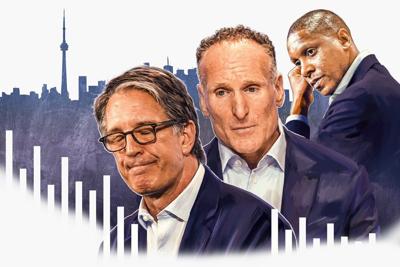At the end of the week that saw Edward Rogers crown himself king of º£½ÇÉçÇø¹ÙÍøsports, a question was raised more than once by insiders: What does his highness’s ascension to the throne mean for Toronto’s sporting presidents?
We’re at a moment in º£½ÇÉçÇø¹ÙÍøsports history, after all, where what amounted to a democracy of sorts is being replaced by a monarchy. Maple Leaf Sports & Entertainment, once ruled by boardroom vote, will now be run precisely as Rogers sees fit. What was once a three-pronged ownership committee that included the family-named corporation Rogers heads, along with its telco competitor Bell and long-time minority stakeholder Larry Tanenbaum, now amounts to a one-man majority. Wednesday’s news of Rogers’s $4.7-billion acquisition of Bell’s 37.5 per cent stake in the organization, which will effectively give Rogers control over 75 per cent of MLSE while minimizing Tanenbaum’s previously considerable influence around the operation, confirmed as much.
History tells us kings and presidents don’t always see eye to eye. And certainly Edward Rogers’s track record says as much. Less than 20 years ago, don’t forget, MLSE had a cheaper, leaner management structure. Brian Burke was president and general manager of the Leafs before Brendan Shanahan took over as president and proceeded to dispose of a long series of general managers apparently more culpable than a decade-plus tenure of playoff failure.
And Bryan Colangelo was president and general manager of the Raptors before Masai Ujiri was brought aboard in 2014 and the two roles — president and general manager — were eventually separated, with Bobby Webster assuming the latter role.
From the Raptors perspective, it’s hard to make the case that the separation of duties has been a bad thing. Ujiri delivered an NBA championship in 2019. Webster is still his trusted right-hand man. Virtually nobody was complaining about the job Ujiri was doing, and the nature of the role he occupied, until 2021, when Ujiri was negotiating a contract extension with MLSE.
- Dave Feschuk, Bruce Arthur
Now, in the few years since, there’s no doubt: Ujiri’s stock is down. But in the lead-up to 2021, he’d arguably had one of the greatest runs in º£½ÇÉçÇø¹ÙÍøsports history, so much so that he was coveted around the globe. The New York Knicks and Washington Wizards took stabs at poaching him. The Los Angeles Lakers played footsie. Even European soccer teams were expressing interest.
Possibly the only person who wasn’t enamoured: Edward Rogers. According to sources cited by the Star in a blockbuster story of the day, Edward Rogers felt strongly enough about his position that he called Ujiri to tell him he wasn’t worth the money he was being offered — a call that infuriated Ujiri to the point he threatened to take a year off. Edward Rogers made the case Webster could run the team just fine at a fraction of the cost, never mind that Webster had never run a team and still hasn’t.
Beyond all that, if Rogers is the savvy businessman his many allies have purported him to be in interviews with this newspaper this week — well, in the matter of Ujiri’s 2021 contract extension, Edward Rogers didn’t even appear to know the rules of NBA business. As the story goes, he was blindsided when Tanenbaum informed him that, as per NBA bylaws, he had unilaterally rubber-stamped Ujiri’s contract extension — as was Tanenbaum’s right as the franchise’s governor. Rogers and his army of lawyers objected, but to no avail.
That’s not to say Ujiri has zero prospects of a future in º£½ÇÉçÇø¹ÙÍøbeyond the 2026 expiration of his contract, if he wants it. Sources say there’s been a softening between Ujiri and Rogers since. Nobody underestimates Ujiri’s ability to survive.
But if cost containment and leaner operations are a Rogers mantra, it’d be foolish to believe º£½ÇÉçÇø¹ÙÍøteam presidents — especially high-priced º£½ÇÉçÇø¹ÙÍøteam presidents — are safe from extinction.
Brendan Shanahan’s public stumbles as Leafs president have certainly made the no-presidents argument easier. Shanahan, in his 11th season, is already on his fourth general manager, fifth if you include Mark Hunter’s brief stint at interim co-GM. And 2023 saw Shanahan’s chief protégé, Kyle Dubas, fired after a palace drama of Shakespearean proportions that spoke not only to Dubas’s misplaced thirst for more power and influence, even in the face of laughable post-season failure, but of Shanahan’s shortcomings as a manager.
It also brought forth a question, whispered not-so-quietly by Dubas’s loyalists: What, precisely, does Shanahan do? If the team’s failure is invariably hung at lower rungs of the hockey operations org chart — and Craig Berube is the fifth head coach of the Shanaplan era — how can it be argued that the guy occupying the highest rung is indispensable, let alone necessary?
We can go on. Mark Shapiro, the Blue Jays president, often avoids the ire of fans upset about another underachieving season. Shapiro’s hand-picked GM, Ross Atkins, takes the bulk of those hits. But if Shapiro isn’t responsible for the performance of the baseball operation — and there are those who say he took his eye off the roster to concentrate on renovations to the stadium and spring training facility — he ought to be paid more like a general contractor than a high-level sports executive. You’d think Edward Rogers, with his eye for maximizing a dollar, might recognize an inefficiency there.
Whether you’re a monarchist or a pragmatist, some º£½ÇÉçÇø¹ÙÍøsports presidents justify their offices better than others. And with Edward Rogers ruling the realm, it’s a decent bet that a thorough justification of such pricey existences will be required soon enough.





























To join the conversation set a first and last name in your user profile.
Sign in or register for free to join the Conversation